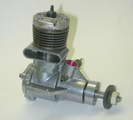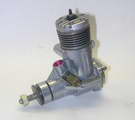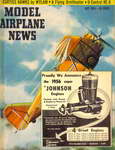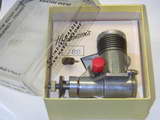| Name | Johnson J-BB 36 | Designer | Hi Johnson |
| Bore | 0.770" | Stroke | 0.770" |
| Type | 2-stroke glow | Capacity | 0.3585 cuin |
| Production run | Mass produced | Country of Origin | USA |
| Photo by | Ron C | Year of manufacture | 1962 |
Background
Dynamic Models Inc of Van Nuys, California, was founded in 1955 by Howard Wilde Johnson, better known as "Hi" Johnson. He was also one half of the KenHi Models partnership which closed the doors in the same year. Johnson was well known for the attractive control line models he'd designed under the KenHi label. Earlier that year he had purchased the all the tools and parts inventory from Henry Orwick, maker of the hot Orwick engines. He produced 5000 Orwick/Johnsons from the parts inventory and began a engine development program. Dynamic Models was formed to manufacture and market his own engine developed from the Orwick glow. The first advertisement for Johnson engines appeared in the July 1955 issue of Model Airplane News where the range were called somewhat futuristically, the 1956 engines.
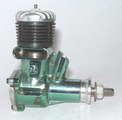
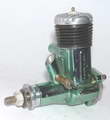 Although the first ad announced four new models, the .64 cuin mentioned was never produced.A source who worked for Henry Orwick states that this was because Hi did not purchase the rights for the 64 from Henry. While the .29, .32, and .35 all showed a distinct Orwick heritage, they incorporated several improvements, some obvious, some not. The dark coloring applied to the drawing in the ad probably reflects the metallic green paint job applied to the crankcase of the .35s. This gave some continuity to the green anodized cases of the last Orwicks which the engine still resembled, although with beam mounting lugs added. It should be noted that this finish was applied to the .35 only, none of the lower displacement engines ever being factory painted [1].
Although the first ad announced four new models, the .64 cuin mentioned was never produced.A source who worked for Henry Orwick states that this was because Hi did not purchase the rights for the 64 from Henry. While the .29, .32, and .35 all showed a distinct Orwick heritage, they incorporated several improvements, some obvious, some not. The dark coloring applied to the drawing in the ad probably reflects the metallic green paint job applied to the crankcase of the .35s. This gave some continuity to the green anodized cases of the last Orwicks which the engine still resembled, although with beam mounting lugs added. It should be noted that this finish was applied to the .35 only, none of the lower displacement engines ever being factory painted [1].
Right from first to last, Johnson engines featured a sintered iron piston. This process is akin to pressure diecasting except a powder substance is used and while heat is involved, it is less than the melting temperature of the alloy. The result is a light piston, free from stress, that requires only reaming for the wrist pin, machining the outer surface, then honing to the bore. Johnson used a domed top design with a low baffle that could not have been produced by machining.
The sintering process is frequently used to make bronze bearings as it produces a porous compound that can retain oil—good for bearings and piston walls, but not so great for the crown! This problem was resolved by impregnating the inside and outside of the dome with a plastic compound during manufacture. Once burned, this acted like case hardening to form a tough crust on both sides of the piston crown that provided good compression, while allowing the walls of the piston to retain the oil retention properties [2]. However, this crust required up to five hours of running to form, hence the long "break-in" period specified for Johnson engines. We'll come back to the sintered pistons later.
The design evolving into a very reliable and robust engine with an admirable reputation in flying circles for combat and stunt (sorry 'bout that  ). The first, lighter model Johnsons were also popular in free-flight power. For the 1960 model, the crankcase was revised to accommodate a larger crankshaft. These are easily distinguished from the earlier models as the prop driver is the same diameter as the front crankshaft journal. The .35 engines based on this case were designated the "Combat Special" and "Stunt Supreme", referred to as the CS and SS respectively. The ball-race BB model, seen here in the standard clear-top Johnson box, did not appear until 1962. Production of all engines finished in 1963.
). The first, lighter model Johnsons were also popular in free-flight power. For the 1960 model, the crankcase was revised to accommodate a larger crankshaft. These are easily distinguished from the earlier models as the prop driver is the same diameter as the front crankshaft journal. The .35 engines based on this case were designated the "Combat Special" and "Stunt Supreme", referred to as the CS and SS respectively. The ball-race BB model, seen here in the standard clear-top Johnson box, did not appear until 1962. Production of all engines finished in 1963.
Description
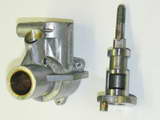 From 1960 on, all models used a monster 5/8" diameter crankshaft journal that permitted a very large gas passage from the front rotary valve inlet. The ball-race engine was available with a conventional needle valve assembly, or with the patented Johnson Auto-mix R/C carburettor. This was one of the first units designed to provide mixture compensation by varying the needle valve setting as the throttle arm was moved. My own experience using the SS and BB models was that they seemed to fling more fuel through the bearing than they used, but they were powerful and reliable, if a bit messy
From 1960 on, all models used a monster 5/8" diameter crankshaft journal that permitted a very large gas passage from the front rotary valve inlet. The ball-race engine was available with a conventional needle valve assembly, or with the patented Johnson Auto-mix R/C carburettor. This was one of the first units designed to provide mixture compensation by varying the needle valve setting as the throttle arm was moved. My own experience using the SS and BB models was that they seemed to fling more fuel through the bearing than they used, but they were powerful and reliable, if a bit messy
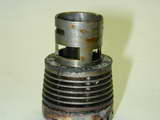 The engines were cross-flow with a hardened liner that incorporated the cylinder cooling fins. The very large exhaust and upper transfer ports were milled with a slim bar in the middle to help prevent the cylinder warping when hot and keep the piston from leaning into the very wide ports. This was very well supported by the bore in the die cast aluminium crankcase to further assist it maintain shape. Passage of gas from crankcase cavity to the transfer passage was augmented via ports in the piston that registered with another in the liner positioned below the transfer outlet port. This design results in some of the fuel/air mix passing through the piston during transfer which helps with cooling and lubricates the small-end bearing. The cylinder head was fully machined and secured by six 4-40 screws; the fore and aft ones being longer than the others. The combustion chamber is "hemi" to match the piston, with a corresponding slot for the baffle. The glow plug was centrally located and vertically aligned.
The engines were cross-flow with a hardened liner that incorporated the cylinder cooling fins. The very large exhaust and upper transfer ports were milled with a slim bar in the middle to help prevent the cylinder warping when hot and keep the piston from leaning into the very wide ports. This was very well supported by the bore in the die cast aluminium crankcase to further assist it maintain shape. Passage of gas from crankcase cavity to the transfer passage was augmented via ports in the piston that registered with another in the liner positioned below the transfer outlet port. This design results in some of the fuel/air mix passing through the piston during transfer which helps with cooling and lubricates the small-end bearing. The cylinder head was fully machined and secured by six 4-40 screws; the fore and aft ones being longer than the others. The combustion chamber is "hemi" to match the piston, with a corresponding slot for the baffle. The glow plug was centrally located and vertically aligned.
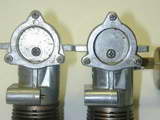 The backplate was secured by three 4-40 screws and tapped for an optional pressure nipple. Users of the Combat Special generally removed the red anodized venturi insert visible in the photos at the head of the page and ran case pressure. In 1961 the crankcase underwent a subtle change with more support provided for the top two backplate screw bosses as seen on the left in this photo. Regrettably this is not a reliable indication of the year of manufacture as many of the final production engines used left-over and reject cases from the earlier series.
The backplate was secured by three 4-40 screws and tapped for an optional pressure nipple. Users of the Combat Special generally removed the red anodized venturi insert visible in the photos at the head of the page and ran case pressure. In 1961 the crankcase underwent a subtle change with more support provided for the top two backplate screw bosses as seen on the left in this photo. Regrettably this is not a reliable indication of the year of manufacture as many of the final production engines used left-over and reject cases from the earlier series.
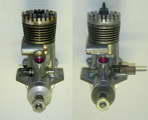 This photo shows the rather brutal modification made to the case in order to accommodate the Auto-mix carb. The workmanship in this case is so much at odds with the rest of the engine that I'm tempted to think this case was a cosmetic reject that was turned into product at the end of the company's life. And yes, the SS on the left has been modified for a muffler and has the "wrong" prop washer and NVA (OS).
This photo shows the rather brutal modification made to the case in order to accommodate the Auto-mix carb. The workmanship in this case is so much at odds with the rest of the engine that I'm tempted to think this case was a cosmetic reject that was turned into product at the end of the company's life. And yes, the SS on the left has been modified for a muffler and has the "wrong" prop washer and NVA (OS).
 One unusual feature of the Johnson series was the use of a rather large slot in the spraybar rather than the more usual fine hole or holes. Many believe this was the secret of the steady running of both the Johnson CS and SS models. I'd be more inclined to attribute this to their being well made and finely finished coupled with a sound, well-developed design. Certainly, to the best of my knowledge, the use of a Johnson-style spray bar has not transformed any poorly performing set-up into an instant winner.
One unusual feature of the Johnson series was the use of a rather large slot in the spraybar rather than the more usual fine hole or holes. Many believe this was the secret of the steady running of both the Johnson CS and SS models. I'd be more inclined to attribute this to their being well made and finely finished coupled with a sound, well-developed design. Certainly, to the best of my knowledge, the use of a Johnson-style spray bar has not transformed any poorly performing set-up into an instant winner.
 |
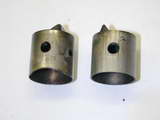 |
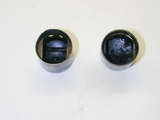 |
We've already mentioned the domed, baffled, sintered iron piston. Quick! Hands up: which other Los Angles based engine manufacturer of the period boasted of a sintered, domed, baffled piston? Well duh, McCoy, naturally. In all three shots above, the piston on the left is from a well used Johnson SS .35; that on the right is from a very, very worn-out McCoy .35 Red Head. There are obvious machining differences. The Johnson has two drilled transfer holes and a crescent cut-out to clear the backplate protrusion at BDC. The McCoy has neither of these features, but it should be noted that the McCoy backplate was cast with a BDC relief for the piston skirt and sold for $5.95 compared to $14.95 for the Johnson. Both pistons are nominally of 0.770" diameter and have identical wrist pins. While there are minor differences evident internally, these could be accounted for in production runs. There is no doubt in my mind that somewhere in LA was a shop specialized in the production of sintered iron parts that supplied McCoy and Dynamic from the same dies.
Look closely at the last photo that shows the interior of the pistons. The granular gunk on the underside of the crowns is not carbon—hopefully there is no combustion taking place inside the crankcase! It would appear that this is a by-product of the crown sealing process mentioned in the introduction.
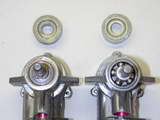 Just to confuse matters, there was a "36B" engine sold as a cheaper sport engine as the company was shutting down production in '63. As you might guess from the single "B" designation, this engine had only one ball race fitted inside the case, the front race being replaced by a plain bronze bearing [3]. The prop driver of the plain bearing engines (SS and CS) engines was keyed to the shaft via a flat in the conventional "D" manner. The driver of the 36BB and 36B was fitted on a split, tapered cone. This makes it difficult to remove the driver to sight the front bearing for identification purposes.
Just to confuse matters, there was a "36B" engine sold as a cheaper sport engine as the company was shutting down production in '63. As you might guess from the single "B" designation, this engine had only one ball race fitted inside the case, the front race being replaced by a plain bronze bearing [3]. The prop driver of the plain bearing engines (SS and CS) engines was keyed to the shaft via a flat in the conventional "D" manner. The driver of the 36BB and 36B was fitted on a split, tapered cone. This makes it difficult to remove the driver to sight the front bearing for identification purposes.
Conclusion:
Howard Wilde (Hi) Johnson was a for-real aero engineer. He graduated from Cal Aero during The Depression and worked for Northrop Aviation in the 1940's. He loved all forms of aviation, surviving the Northrop Flying Wing crash that killed Richard DuPont. He was killed in 1981 when he pulled the wings off the sailplane he was piloting [4]. |
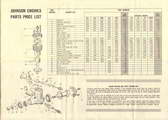 |
 |
As well as the Johnson engines and model accessories, Dynamic Inc manufactured the Holland Hornet and the short-lived and un-loved Bulldog 09. To go with the Automix throttle, Hi Johnson designed and sold an auto-pitch two blade prop that reduced the pitch as the rpm decreased, the intent being to produce less thrust at higher idle speeds. This unit also featured replaceable blades.
In my neck of the woods in the late 1950's and early 60's, Johnson was the engine to have. In preparing this page, I re-read all of Peter Chinn's Johnson reviews: three in MAN and one in the British magazine, Model Aircraft. Illustrating magazine lead times, this latter one appeared after the company had disappeared (see the Model Engine Review Index page). Chinn always gave the engine top marks [5] and so do I.
References:
| [1] | Dannels, T: American Model Engine Encyclopedia 1911 to 1975, Country View Enterprises, CO USA, 2005, p123. |
| [2] | annon: Powerplant review: Hi's Radio Mill Proves Potent Yet Docile .35, American Modeler, Condé Nast Publications Inc, NY USA, Volume 57, Number 5, February 1962, p32. American Modeler, |
| [3] | Anderson, FH: Anderson's Blue Book 4th Edition: American Model Airplane Engines 1911-2005, [no publisher stated], USA, 2005, p52. |
| [4] | Thornburg, D: Do You Speak Model Airplane? The Story of Aeromodeling in America, Pony X-Press, New Mexico, USA, 1992, p302. |
| [5] | Chinn, PGF: Engine Review Johnson J-R/C .36, Model Airplane News, Air Age Inc, New York, Vol LXVI, No 3, September 1962, p28. |
![]()
